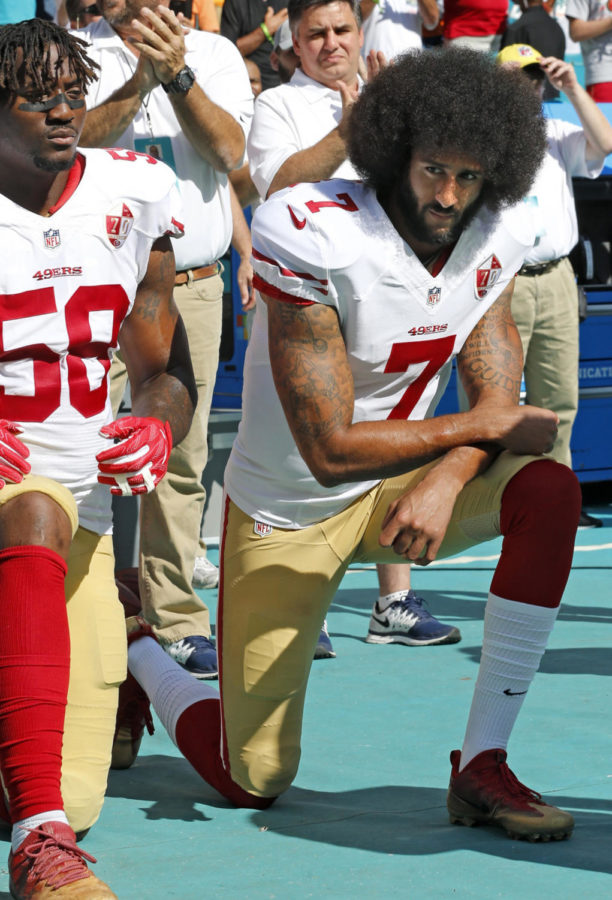Nike Finally Stands With the Man Who Took a Knee
The decision to make athlete-turned-activist Colin Kaepernick was more clever and calculated than people think.
PHOTO | TNS
Kaepernick brought on nationwide debate when he took a knee during the National Anthem to protest the unlawful killing of black men and women by police officers.
The face of former 49ers quarterback Colin Kaepernick, the man behind the “take a knee” protests in the NFL, has been on nearly every billboard, every news station, and in every conversation for the past few weeks. Nike announced him as their newest endorsement as well as the new voice behind the “Just Do It” ads on Sept. 3. “Believe in something. Even if it means sacrificing everything,” are Kaepernick’s words in the ads.
Since then, there have been widespread calls for boycotts, public outrage and videos of people burning their already-bought Nike gear. What may have, at this point, looked like a thoughtless risk to their company because of the backlash that ensued is actually an extremely calculated stroke of genius when it comes to catering for their target audience and increasing their public image, especially among young people.
Choosing a controversial spokesperson to represent their brand is nothing new for Nike. They have continued to endorse professional golfer Tiger Woods since 1996, never hesitating to renew his contract even through his infidelity scandal and his DUI arrest.
Nike even endorsed professional tennis player Andre Agassi in 2014 after he wrote about his crystal meth use.
Nike is a multi-billion dollar company. They know what they’re doing and they know their consumers well. Nike knew that younger consumers (Generation Z and most millennials) were most likely to react positively to those who knelt for the National Anthem according to a survey by Morning Consult. Since their primary market is young athletes, according to Business Insider, the situation was sure to produce positive results. Even through backlash was absolutely certain, however, in this case, the backlash was a good thing for the ad since it would likely ensure that the ad would be everywhere throughout the media.
When news first broke of Kaepernick’s hire as the face of Nike, social media was up in arms, with some passionately defending Nike’s actions and others vehemently opposing the public endorsement of Kaepernick’s actions. The hashtag #BoycottNike received over 100,000 tweets in just the first 24 hours according to NBC. However, it should be noted that the majority of these were positive, according to Market Watch.
Then President Trump publicly shamed Nike for their decision in making Kaepernick their spokesperson. And, for a day or so, it seemed like it worked. After announcing Kaepernick as their newest face of the ‘Just Do It’ ads, the company lost almost $4 billion, according to The Wrap.
Yet despite this short-lived boycott of Nike products, they have actually grown, with sales rising 31 percent according to NBC. In addition, they received over $42 million in free advertising. The phrase “any publicity is good publicity” is exactly what happened with this. Though the media was mostly mixed on the issue with some being completely for it and others avidly against it, pictures with Kaepernick’s face and Nike’s logo were on nearly every news story. Whether these publications meant to do it or not, they furthered the outreach of Nike and their campaign no matter if their coverage was positive or negative. Nike perpetrated the controversy on purpose, knowing the benefits that were sure to come with it.
Though this may seem like Nike is expressing what it truly believes and is taking a stand against racism in the United States, in reality it is about making money and nothing else. If this was about more than making money, Nike would have endorsed Kaepernick two years ago. If this truly was for social change and in genuine support of what Kaepernick stood up for, or, rather, knelt for, then they would have made this very public display of support when he was being torn apart by the media, or when his job was up in the air for the NFL, or when he was receiving thousands upon thousands of death threats.
Two-thirds of consumers want brands to take a stand on important social and political issues, according to Ad Week. Instead of striking fast and supporting Kaepernick at the heart of his controversy, Nike waited until it was less of a hot topic to make millions on it, knowing that people in their target demographic would be in support of them taking a stand with Kaepernick. Nike could’ve had the power to better his reputation when he needed it the most by providing their public support.
But now, because of its timing, it seems like a thinly veiled marketing ploy, using Kaepernick to better both their reputation and their sales by using him as the face and voice of their ad. If they would have done it in the heart of the controversy it would have seemed much more real. Now it just feels like little more than an attempt to boost their brand.
Whether the general public agrees with Nike’s decision or with Kaepernick’s activism, Nike has consumers and the media right where they want them– providing millions in free advertising, their public image being boosted for their supposed “activism” and still churning out millions of dollars.




Anonymous • Sep 14, 2018 at 4:20 PM
This has got to be one of the most insightful articles I have ever read! Ms. Barackman wrote, “Their public image being boosted for their supposed “activism” and still churning out millions of dollars.” This really makes you think. Nike knew what they were doing, and that is why their sales are up 31% after this event!
Ms. Barackman hit a home run with this article! Great wording! Very talented! Thank you for this!